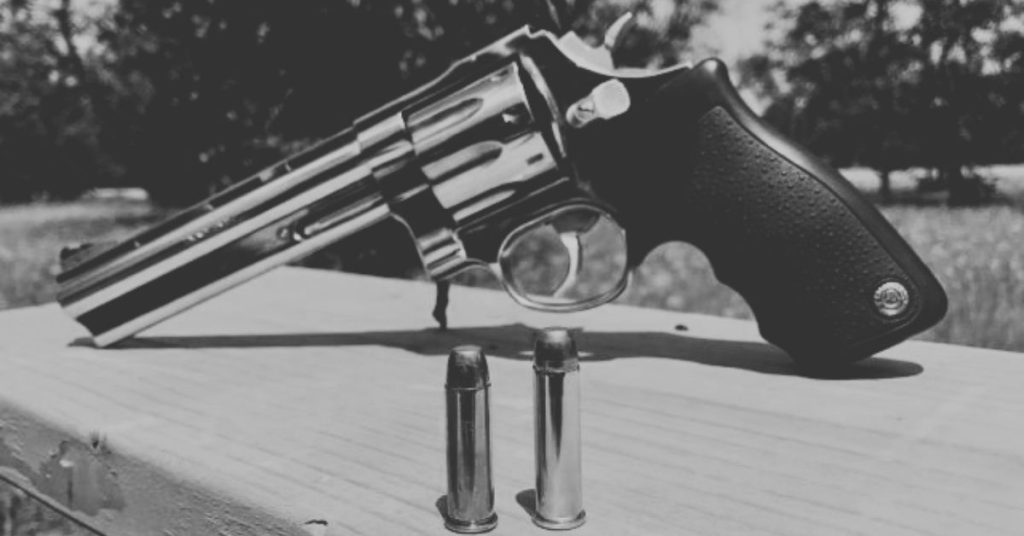Savvy shooters check out many calibers and types of ammo before making a final choice. Choosing self-defense ammo is equally, if not more important, than buying rounds for any other use. Self-defense situations can happen in the home, on the street, or in close quarters. Knowing how to shoot the right handgun with the right ammo can make the difference between life and death.
The .357 Magnum makes an excellent self-defense round. It offers power and accuracy while remaining easier to shoot than some larger calibers.
History
In 1934, the team of Philip B. Sharpe, Elmer Keith, and Col. D. B. Wesson of Smith and Wesson and Winchester developed .357 Magnum ammo to compete with Colt’s .38 Super Automatic. The initial bullet design was based on S&W’s .38 Special.
At the time, the .38 Super Automatic was the only cartridge on the American market touting a muzzle velocity above 1,000 FPS. Law enforcement chose the popular .38 because it was powerful enough to go through auto glass and ballistics vests often used by gangsters.
As a result, police were impressed by the power of the .357 Mag as it could outperform almost all revolver ammo on the market.
The remarkable performance of the .357 Magnum ensured that it stayed front and center on law enforcement’s radar for decades. The ammunition was inexpensive and easy to buy.
The historic 357 Magnum revolver gives the user a sense of history and power. Even in today’s market, the six-shooter commands respect.
Development
Keith was given much of the credit for designing the .357 Magnum. However, each man did a fair share of the work. First, Col. Wesson saw the possibilities of the new ammunition.
He planned to use the .357 to make S&W the sole provider of arms and ammo for law enforcement. Second, Sharpe, a member of the technical staff of the National Rifle Association.
Gave technical expertise to the project. Based on the S&W .38 Special, the .357 required a longer casing and different powder load. Extending the .357 case by 1⁄8” was an important safety measure.
It prevented a .357 from being fired in a .38 Special revolver. The higher pressure of the .357 promised disastrous results if fired from the less powerful handgun.
Today, most experts credit .357 ammo for starting the “Magnum Era.” Shooters like the dual-purpose handgun cartridge for its versatility since it can be used for hunting, target shooting, plinking, and self-defense.
It offers superior stopping power, yet the long barrel is light on recoil. While there may be more powerful ammunition on the market, the .357 is easy to control and provides high accuracy.
Current Design
The .357 ammo cartridge has evolved since it was launched in 1935. Smith & Wesson altered Keith’s design, slightly reducing the size. Keith tended to oversize his ammunition, so the change wasn’t unexpected. The redesigned model became known as the Sharpe bullet.
After conducting several experiments, Winchester made more modifications while maintaining the contour designed by Sharpe. The final design was a combination of the two rounds. Currently, the rimmed centerfire cartridge – the most popular handgun style – has been in use by law enforcement as a standard issue for their service weapons.
It is also known as the .357 S&W Magnum or 9x33mmR. Its measurements: .357” (9.1mm) diameter bullet enclosed in a 1.29” case, with the total length of the cartridge at 1.59”. Its maximum pressure is 35,000 PSI with an average velocity of 1,090 FPS.
Development and Design
The design team changed the .357 Magnum little from Keith’s original design. Today’s model, also known as the .357 S&W Magnum, or the 9x33mmR, is a rimmed centerfire cartridge that has a .357 inch (9.1mm) diameter bullet in a case measuring 1.29 inches in length.
The total length of the round is 1.59 inches. Its max pressure is 35,000 psi with an average muzzle velocity of 1,090 feet per second (fps).
.357 Mag vs. .357 SIG
In the 1990s, Federal Premium joined Swiss-German firearms manufacturer SIG Sauer to create a round to compete with the popular .357 Magnum.
The team wanted to duplicate the performance and versatility of the .357 Mag while giving shooters the option for a higher capacity. SIG originally designed the ammo to be .357 in, but it was cut down to .355 in for easier reloading.
SIG wanted to use the ammo to tap into the law enforcement market. Surprisingly, the smaller, but equally powerful .357 SIG never caught on. Still, it is used by target shooters and people interested in carrying for self-defense.
Popularity and Use
The .357 Magnum revolver quickly became a favorite with law enforcement and military units. Soldiers and officers carried the gun throughout WWII and the Vietnam War. General George S. Patton is one of the weapon’s most famous fans; he carried an ivory-handled S&W .357 Magnum on one hip and another ivory-handled, single-action .45 Long Colt on the other.
The Vietnam War didn’t end the popularity of the .357 Magnum. Security guards, police officers and members of the U.S. Special Forces use the famous gun and ammo.
Although it has been replaced in most instances with semi-automatic pistols, the .357 still has its place among law enforcement as a backup weapon.
Firearms enthusiasts, law enforcement officers and hunters still choose the .357 Magnum, which is why it is still one of the most popular high-velocity cartridges on the market today.
Using a .357 Magnum Revolver
Public opinion typically likes a larger caliber semi-automatic for personal defense. However, .357 Magnum revolvers hold their own and even outshine the competition in some areas.
First, revolvers handle well. They allow the shooter to act fast and have an accurate shot.
Second, revolvers operate easily without much thought. In a home defense situation, acting fast could mean the difference between life and death.
Third, shooters like the lighter weight of a revolver. They like a gun with a compact frame. This allows the user to carry concealed or travel without much difficulty.
Fourth, revolvers stay popular which means they are easy to find and are affordable. People who use the gun for self-defense purposes only like a gun within their budget.
Lastly, .357 revolvers shoot .38 Special rounds. The cartridges match in every way but length. Therefore, the .357 can shoot .38 Special ammo. The reverse is not true.
Shooting less powerful ammo helps beginners handle recoil and muzzle blast. It also allows for a lighter trigger pull on guns with a shorter barrel length.
Best .357 Magnum for Self-Defense
Experts showcase top choices for .357 for self-defense. Each brings the power, accuracy and velocity needed in any self-defense situation. The downsides for the .357 include a bright muzzle flash, stiff recoil, and loud report.
These items distract newbies from maintaining accuracy on multiple shots. However, using a bullet with fewer grains will lessen these issues.
Federal Ammunition 158 Grain JHP
- 1,240 FPS Muzzle Velocity
- 158 Grain
- Jacketed Hollow Point Bullet
- Nickel-plated Brass Casing
- Boxer Primer
- 539 ft-lbs. Muzzle Energy
Buffalo Bore Tactical Short Barrel 158 Grain JHP
- 1,400 FPS Muzzle Velocity
- 158 Grain
- Jacketed Hollow Point Bullet
- Nickel-plated Brass Casing
- Boxer Primer
- 606 ft-lbs. Muzzle Energy
Federal American Eagle Cartridge 158 Grain JSP
- 1,240 FPS Muzzle Velocity
- 158 Grain
- Jacketed Soft Point Bullet
- Nickel-plated Brass Casing
- Boxer Primer
- 530 ft-lbs. Muzzle Energy
Fiocchi 142 Grain FMJ-TC
- 1,420 FPS Muzzle Velocity
- 158 Grain
- Full Metal Jacket Bullet
- Nickel-plated Brass Casing
- Boxer Primer
- 636 ft-lbs. Muzzle Energy
Speer Gold Dot Short Barrel 135 Grain JHP
- 990 FPS Muzzle Velocity
- 135 Grain
- Jacketed Hollow Point Bullet
- Nickel-plated Brass Casing
- Boxer Primer
- 294 ft-lbs. Muzzle Energy
Hornady Critical Defense 125 Grain FTX
- 1,500 FPS Muzzle Velocity
- 125 Grain
- FlexTip Bullet
- Nickel-plated Brass Casing
- Boxer Primer
- 824 ft-lbs. Muzzle Energy
CCI Blazer 158 Grain JHP
- 1,150 FPS Muzzle Velocity
- 158 Grain
- Jacketed Soft Point Bullet
- Nickel-plated Brass Casing
- Boxer Primer
- 464 ft-lbs. Muzzle Energy
Tula Ammo 158 Grain FMJ
- 1,280 FPS Muzzle Velocity
- 158 Grain
- Full Metal Jacket Bullet
- Steel Casing
- Boxer Primer
- 464 ft-lbs. Muzzle Energy
Barnes 140 Grain VOR-TX JHP
- 1,265 FPS Muzzle Velocity
- 158 Grain
- Jacketed Soft Point Bullet
- Copper Casing
- Boxer Primer
- 498 ft-lbs. Muzzle Energy
Federal Premium Power-Shok 158 Grain JHP
- 1,240 FPS Muzzle Velocity
- 158 Grain
- Jacketed Hollow Point Bullet
- Nickel-plated Brass Casing
- Boxer Primer
- 539 ft-lbs. Muzzle Energy
Ruger ARX 86 Grain
- 1,650 FPS Muzzle Velocity
- 158 Grain
- Injection Molded Copper Polymer ARX Projectile
- Brass Casing
- Boxer Primer
- 552 ft-lbs. Muzzle Energy
Hornady American Gunner 125 Grain JHP XTP
- 1,500 FPS Muzzle Velocity
- 125 Grain
- Jacketed Hollow Point Bullet
- Nickel-plated Brass Casing
- Boxer Primer
- 624 ft-lbs. Muzzle Energy
PMC Bronze 158 Grain JSP
- 1,471 FPS Muzzle Velocity
- 158 Grain
- Jacketed Soft Point Bullet
- Nickel-plated Brass Casing
- Boxer Primer
- 759 ft-lbs. Muzzle Energy
Sellier & Bellot 158 Grain FMJ-FN
- 889 FPS Muzzle Velocity
- 158 Grain
- Full Metal Jacket Bullet
- Nickel-plated Brass Casing
- Boxer Primer
- 278 ft-lbs. Muzzle Energy
Federal Premium Barnes Expander 140 Grain JHP
- 1,400 FPS Muzzle Velocity
- 140 Grain
- Jacketed Soft Point Bullet
- Nickel-plated Brass Casing
- Boxer Primer
- 609 ft-lbs. Muzzle Energy
Remington Ammunition: 110 Grain SJHP
- 1,295 FPS Muzzle Velocity
- 110 Grain
- Semi Jacketed Hollow Point Bullet
- Nickel-plated Brass Casing
- Boxer Primer
- 410 ft-lbs. Muzzle Energy
Conclusion
Experts consider .357 Magnum an excellent self-defense round for novices through to seasoned professionals. The ammo carries the power necessary to dominate in any situation. While larger calibers bear the stigma of over penetration, the .357 is less likely to go through the target.
Although safety is paramount, a .357 is a desirable weapon for beginners without considerable training. For more information on 357 Magnum ammo check out “Best .357 Magnum Ammo for Self-Defense, Range Training & More.”

